Featured in Sampson Boat Co.
This week we have the honor to be featured in Sampson Boat Co’s episode were we help Leo hot rivet the Gaff Saddle of Tally-Ho, a famous sailing cutter yacht that has been completely restored and documented on YouTube.

This week we have the honor to be featured in Sampson Boat Co’s episode were we help Leo hot rivet the Gaff Saddle of Tally-Ho, a famous sailing cutter yacht that has been completely restored and documented on YouTube.
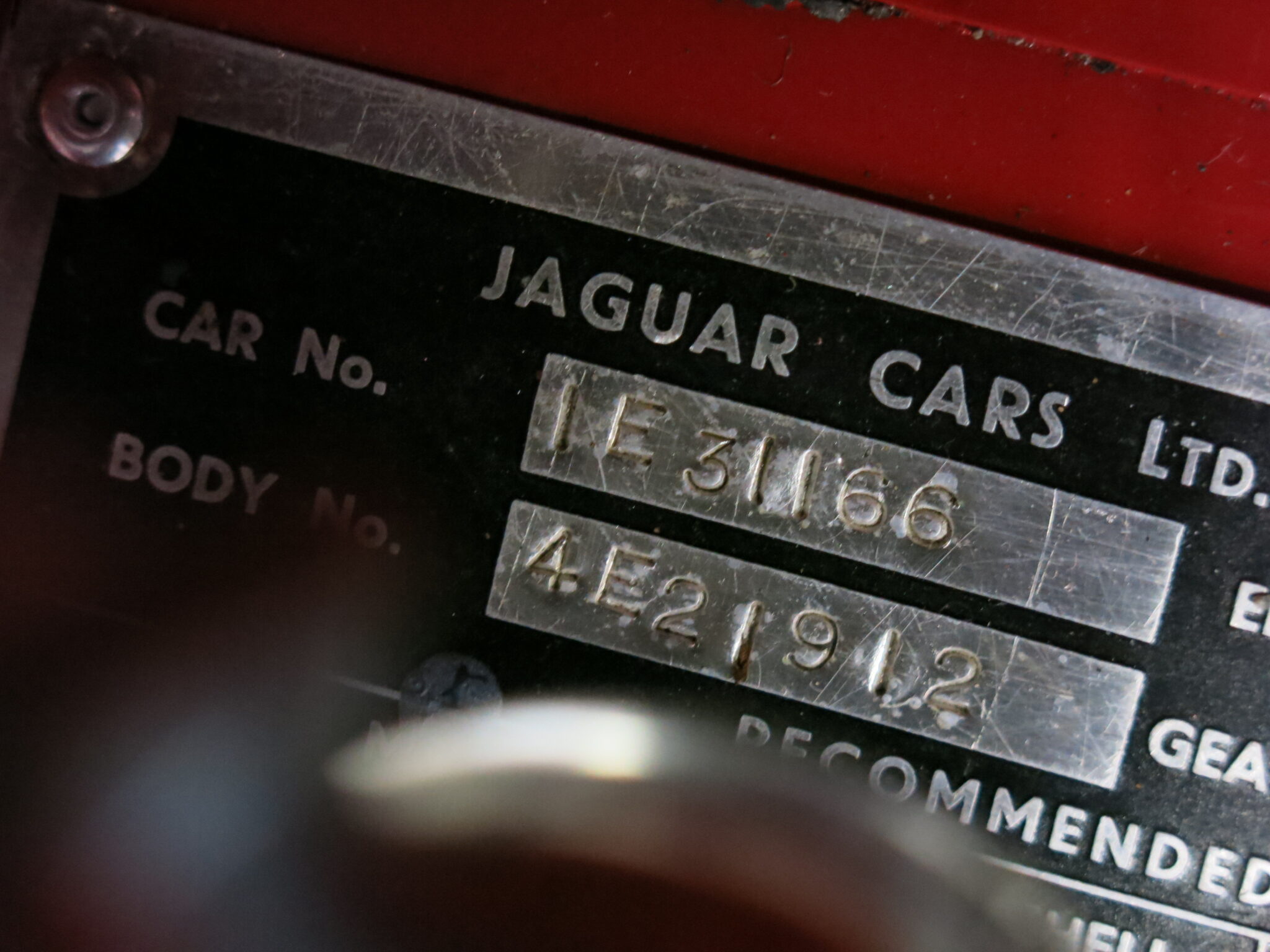
This document shows factory production data for the Jaguar E-type Series 1 model in both 3.8 and 4.2-litre configuration as well as Jaguar E-type Series 2 4.2-litre compiled by the author and Jaguar Daimler Heritage Trust. It includes details on first chassis numbers by year for right-hand drive (RHD) and left-hand drive (LHD) models, and is divided into open two-seater (OTS) and fixed-head coupes (FHC) and 2+2.
Many countries titled cars on date of import instead of date produced, including USA and Canada which were often one-year out. Many documents such as Certificate of Title, Vehicle Ownership or Registration Certificate can mismatch date of manufacture.
Furthermore the state of California added a J-Tag near the chassis tag and prefixed cars J62, J63, J64, J65, J67, J68, J69 depending on year of import. For example the above car could have been registered J651E31166 or J661E31166 in the state of California. French import cars had an additional tag mounted on the RHF firewall.
Each body type has an independent linear sequence which means the number indicated only specifies the production within a particular type. Using our example chassis tag above, car 1E31166 is the 1166th LHD FHC produced with the OTS having a separate sequence. With this system is is possible for many cars to share the same number with a different prefix.
To get an accurate Heritage Document on the production data of any Jaguar a formal request can be to be submitted to the Jaguar Daimler Heritage Trust https://www.jaguarheritage.com/
Jaguar E-type Series 1 3.8 (15,496 produced)
| Year | OTS RHD | OTS LHD | FHC RHD | FHC LHD |
| 1961 | 850001 | 875001 | 860001 | 885001 |
| 1962 | 850328 | 876471 | 860134 | 885399 |
| 1963 | 850646 | 878863 | 861052 | 888035 |
| 1964 | 850808 | 880808 | 861434 | 889752 |
| Last | 850943 | 881886 | 861799 | 890872 |
| Total Production | 942 | 6885 | 1798 | 5871 |
In January 1962, E-Type production had a major body revision including a new dished floor panel also known as a heel well that was a considerable upgrade. Floor assemblies changed from BD15171 to BD23141 and these cars came with longer clutch pedal, longer brake pedal and revised carpet to match. Around this same time the bonnet louvres becoming integral instead of a welded insert panel.
Earlier cars became known as Flat Floor with a total of 2616 flat floor cars with breakdown as as follows:
| Flat Floor Production | OTS RHD | OTS LHD | FHC RHD | FHC LHD |
| Final Flat Floor | 850357 | 876581 | 860175 | 885503 |
| Total Flat Floor | 357 | 1581 | 175 | 503 |
Around May/June 1962 it is important to note that Jaguar completely revisited the component level body production for all cars to ramp up production. Many sub-assembles switched suppliers, such as Pressed Steel to Abbey Panels for the FHC rear hatch. This revision started with chassis 850527/860581/877356/886093.
This large production revision outlined a specific body structure that would not change in any major capacity until 1971 with the introduction of the LWB S3 V12 model. This mid-1962 change point is when the monocoque and engine subframes were sufficiently modified for strength and passenger comfort.
E-Type floors and sills were modified and most notably, twin dished recess panels were included in the rear bulkhead behind seats. These work in conjunction with modified seat tracks that allow 1.5 inches of extra legroom.
Along with the dished rear firewall, the lightweight Reynolds 531 bonnet subframe featured larger gussets and the floor section was also modified with new jacking points and sills.
During this period the FHC received entirely new rear bodywork including rear fenders, rear boot hatch, rear boot hatch glass, rear boot prop rod, tail panel, fuel filler flap and rear signal light bases. This had the negative effect of limiting the first 1,491 coupes, or 13.6% of total production to different rear boot hatch metalwork and glass. FHC bodywork changed around coupe 860478/886013:
| Early FHC Body | RHD | LHD |
| Last Early FHC Body Made | 860478 | 886013 |
| Total Early FHC Body | 478 | 1013 |
Jaguar E-type Series 1 4.2 (22,916 produced)
| Year | OTS RHD | OTS LHD | FHC RHD | FHC LHD | 2+2 RHD | 2 + 2 LHD |
| 1964 | 1E/1001 | 1E/10001 | 1E/20001 | 1E/30001 | ||
| 1965 | 1E/1078 | 1E/10441 | 1E/20139 | 1E/30454 | 1E/50001 | 1E/75001 |
| 1966 | 1E/1435 | 1E/12348 | 1E/21155 | 1E/32474 | No record | 1E/75010 |
| 1967 | 1E/1705 | 1E/14472 | 1E/21473 | 1E/34072 | 1E/50676 | 1E/76986 |
| 1967 S1.5 | 1E/1864 | 1E/15980 | 1E/21584 | 1E/34583 | 1E/50975 | 1E/77709 |
| 1968 S1.5 | 1E/1995 | 1E/16653 | 1E/21744 | 1E/34984 | 1E/51117 | 1E/77860 |
| Last | 1E/2183 | 1E/18367 | 1E/21958 | 1E/35814 | 1E/51379 | 1E/79221 |
| Total Production | 1182 | 8366 | 1957 | 5813 | 1378 | 4220 |
| S1.5 Production | 320 | 2479 | 375 | 1565 | 404 | 1577 |
Jaguar E-type Series 2 4.2 (18,808 produced)
| Year | OTS RHD | OTS LHD | FHC RHD | FHC LHD | 2+2 RHD | 2+2 LHD |
| 1968 | 1R/1001 | 1R/7001 | 1R/20001 | 1R/25001 | 1R/35001 | 1R/40001 |
| 1969 | 1R/1075 | 1R/8126 | 1R/20127 | 1R/25601 | 1R/35119 | 1R/40799 |
| 1970 | 1R/1499 | 1R/12201 | 1R/20605 | 1R/27572 | 1R/35697 | 1R/43437 |
| Last | 1R/1776 | 1R/14853 | 1R/21071 | 1R/28786 | 1R/36041 | 1R/44287 |
| Total Production | 775 | 7852 | 1070 | 3785 | 1040 | 4286 |
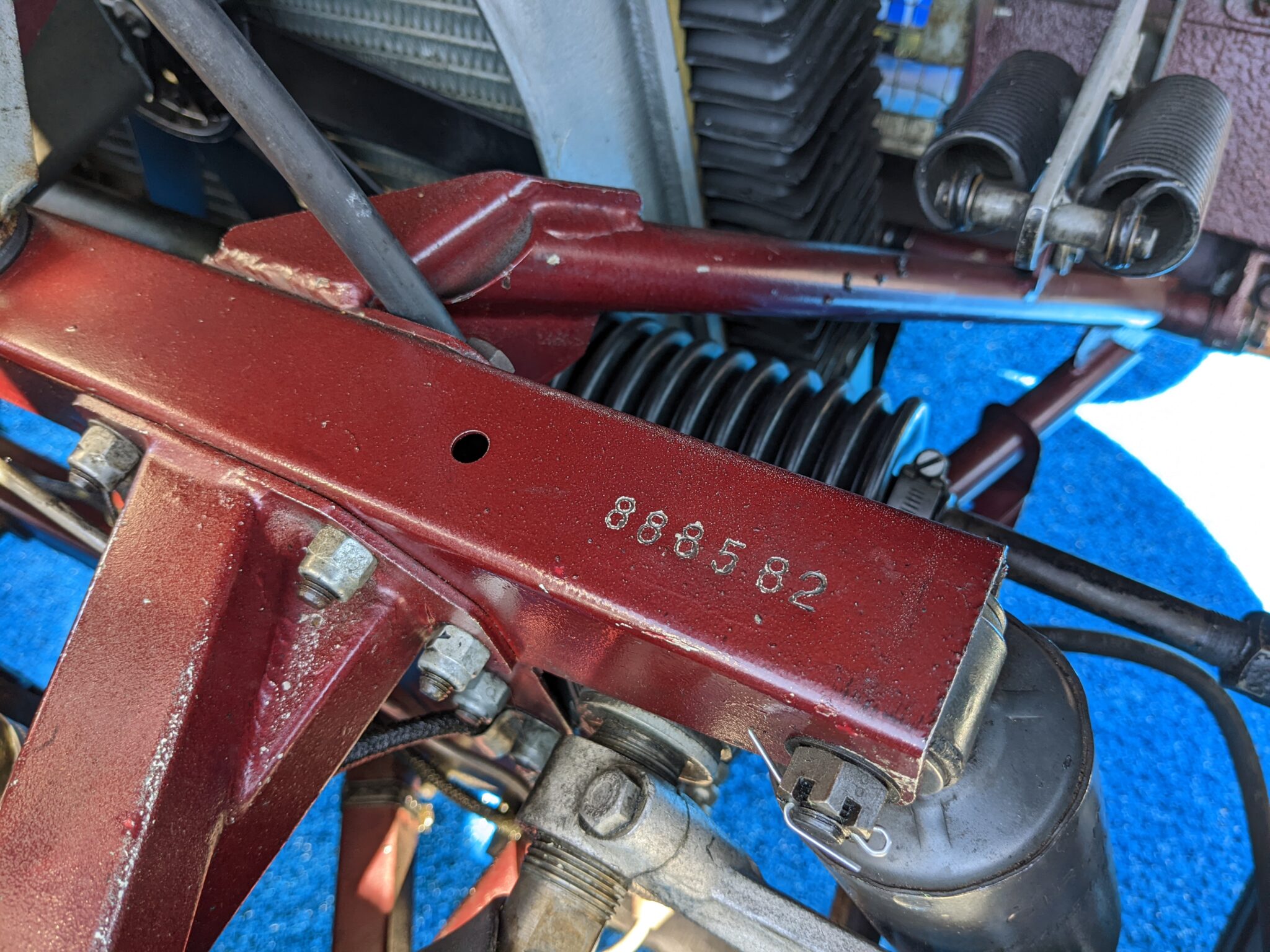
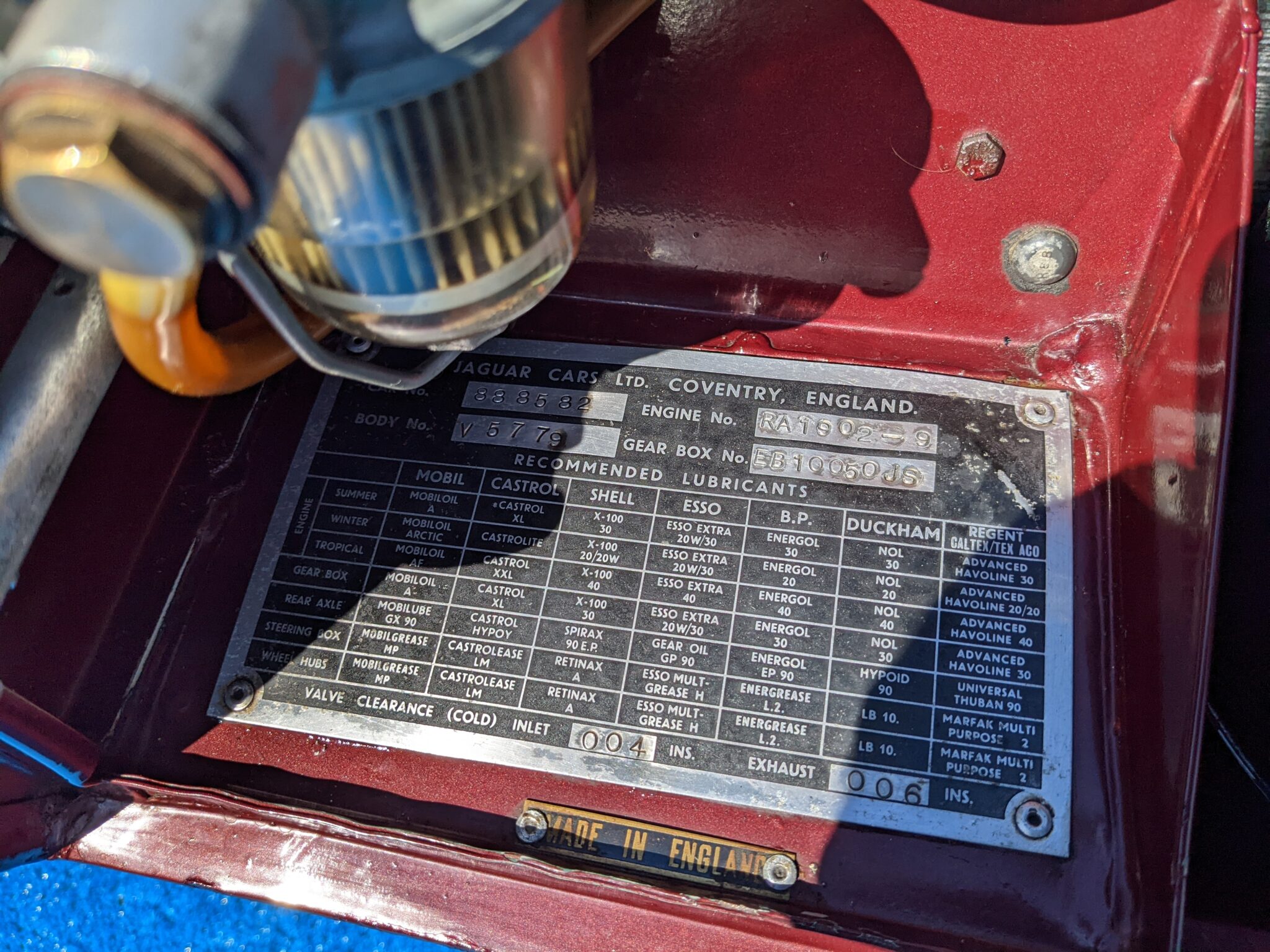
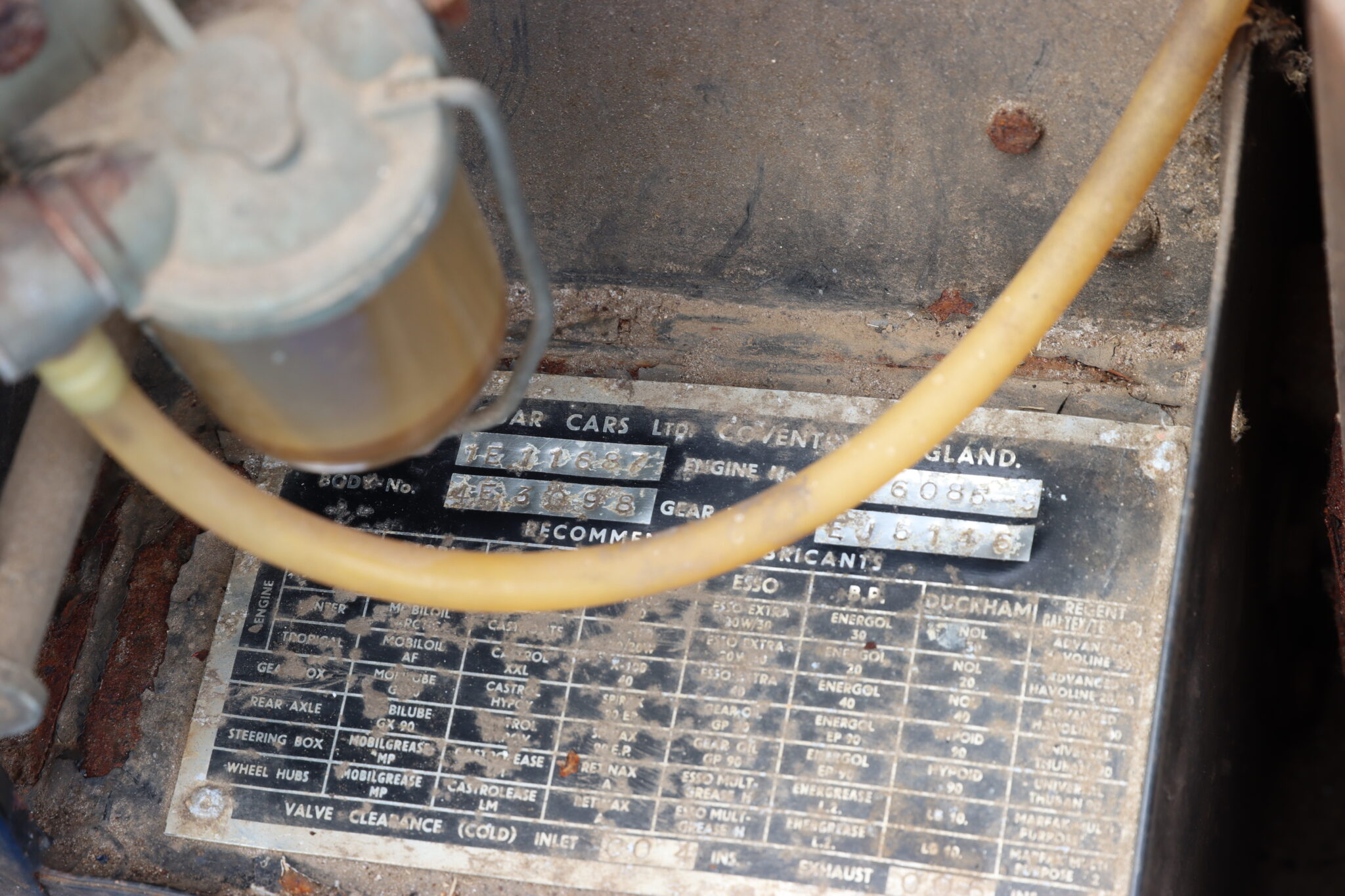
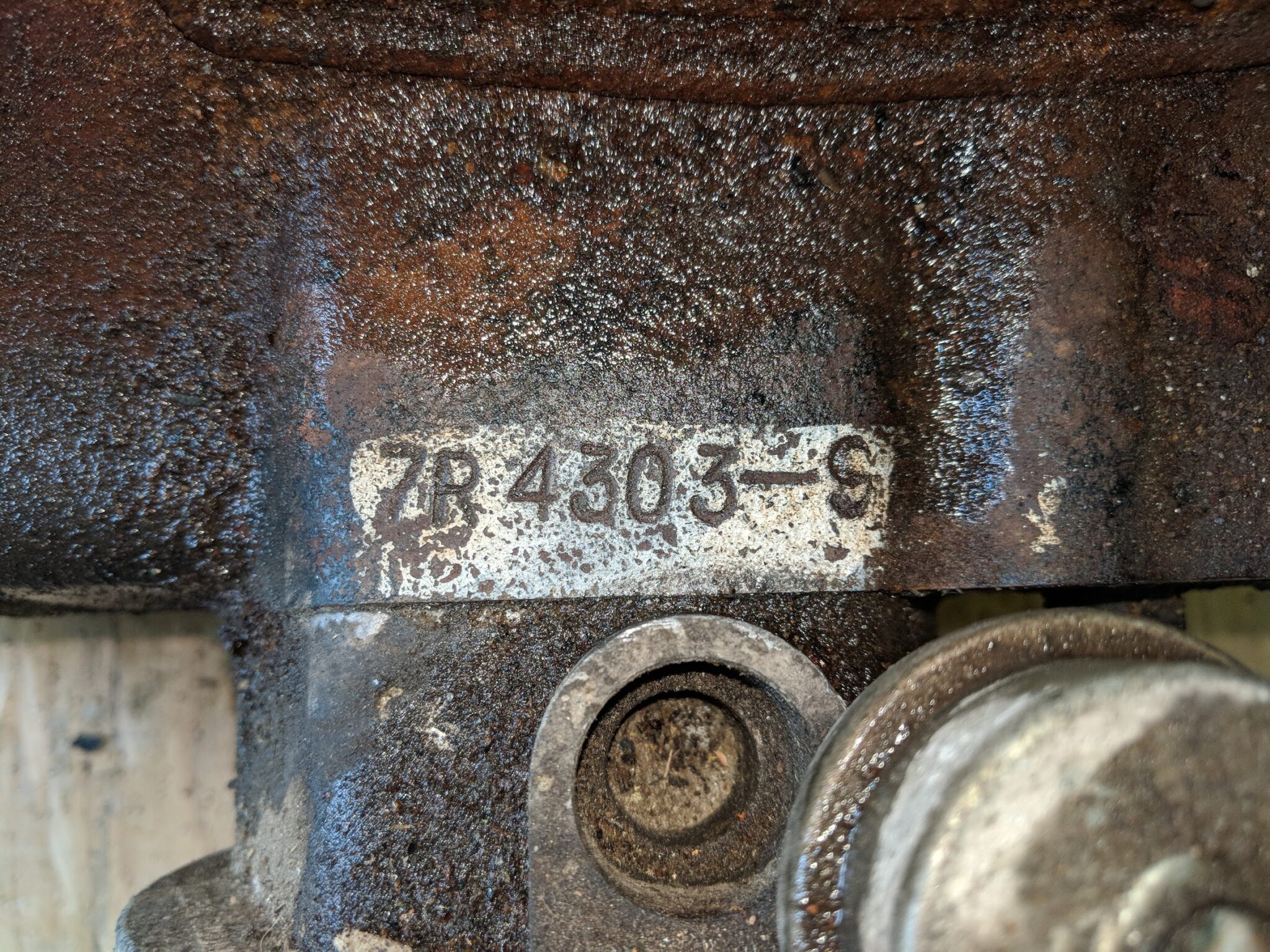
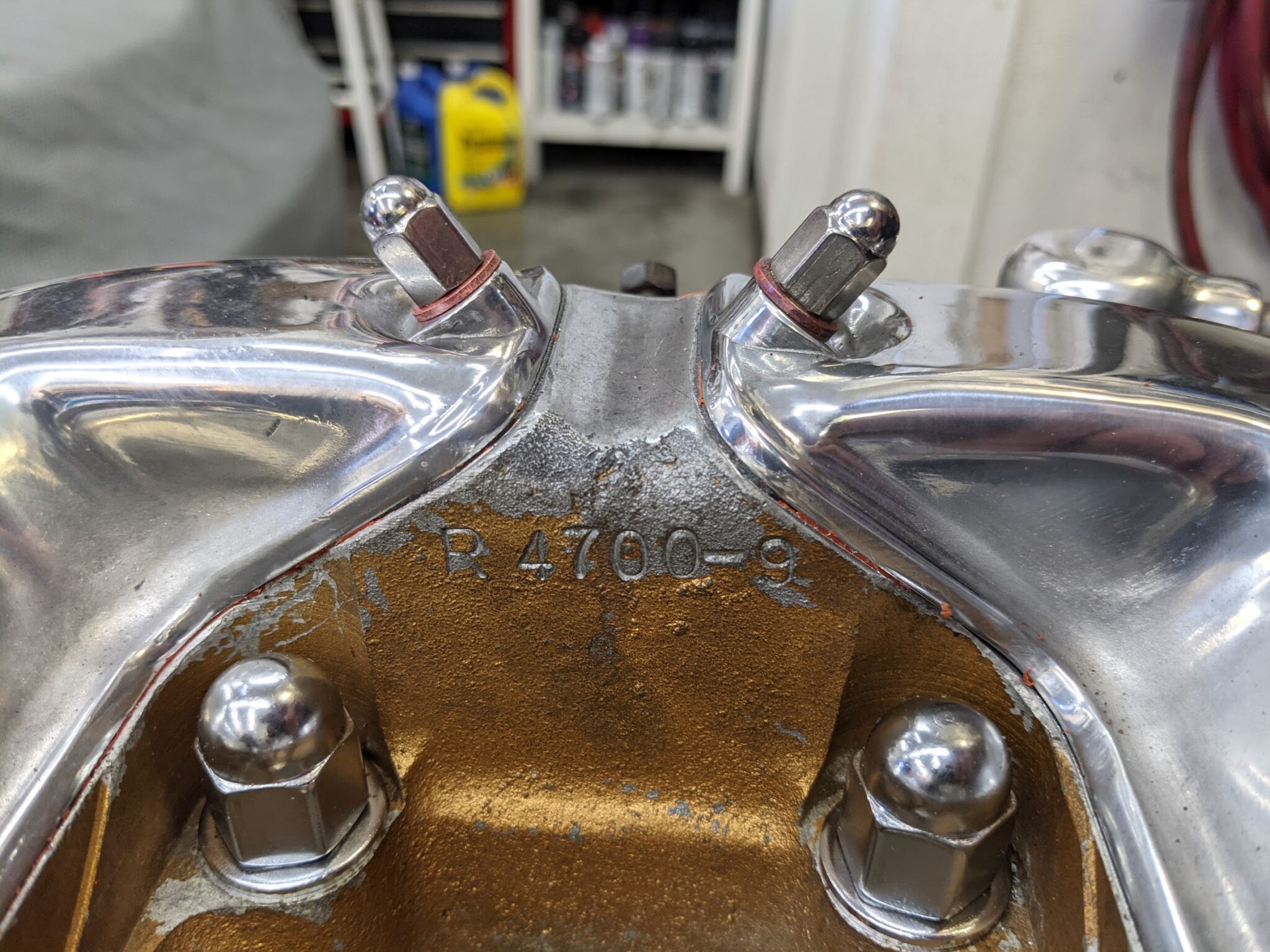
In this video we do final dry assembly of a 1961 AC ACE-Bristol BEX1169 and a 1952 Jaguar XK120 FHC Chassis 679514. On the Ace we fit the grill, headlight rings, doors, hood, trunk then do a testdrive. XK120 work included rebuilding the Lucas C45PVS Generator then doing a first engine run.
Owen Automotive is excited to share the discovery and purchase of 1962 Jaguar E-Type FHC chassis 885307 from a barn in Surrey BC, CANADA. It has not been seen since long-term storage starting in 1976.
This is an important discovery for early E-Type Coupes as this is the the 307th LHD Coupe of only 500 with the early design features such as welded-in hood louvres and a flat floor.
Furthermore this car is fully matching numbers with its original and rebuilt engine, cylinder head and all the date-coded components including the starter, generator, distributor, hydraulic master cylinders, washer motor and wiper motor.
This car was purchased in 1968 from Montreal and subsequently spent its life on the west coast of BC with Guy W. Newman of Newtronics Industries Ltd. audio and video systems. At his time it was fitted with an Eight-Track stereo and likely seen at Honey Bear’s Disco on 571 Seymour St in Vancouver BC.
We have purchased it in a state of disassembly and engine rebuild which began in 1976. That leaves us with the task of continuing the work to reunite engine R2938 with car. At one point the owner stored his engine in the master bedroom which might explain the white paint and chrome hardware.
More to come!
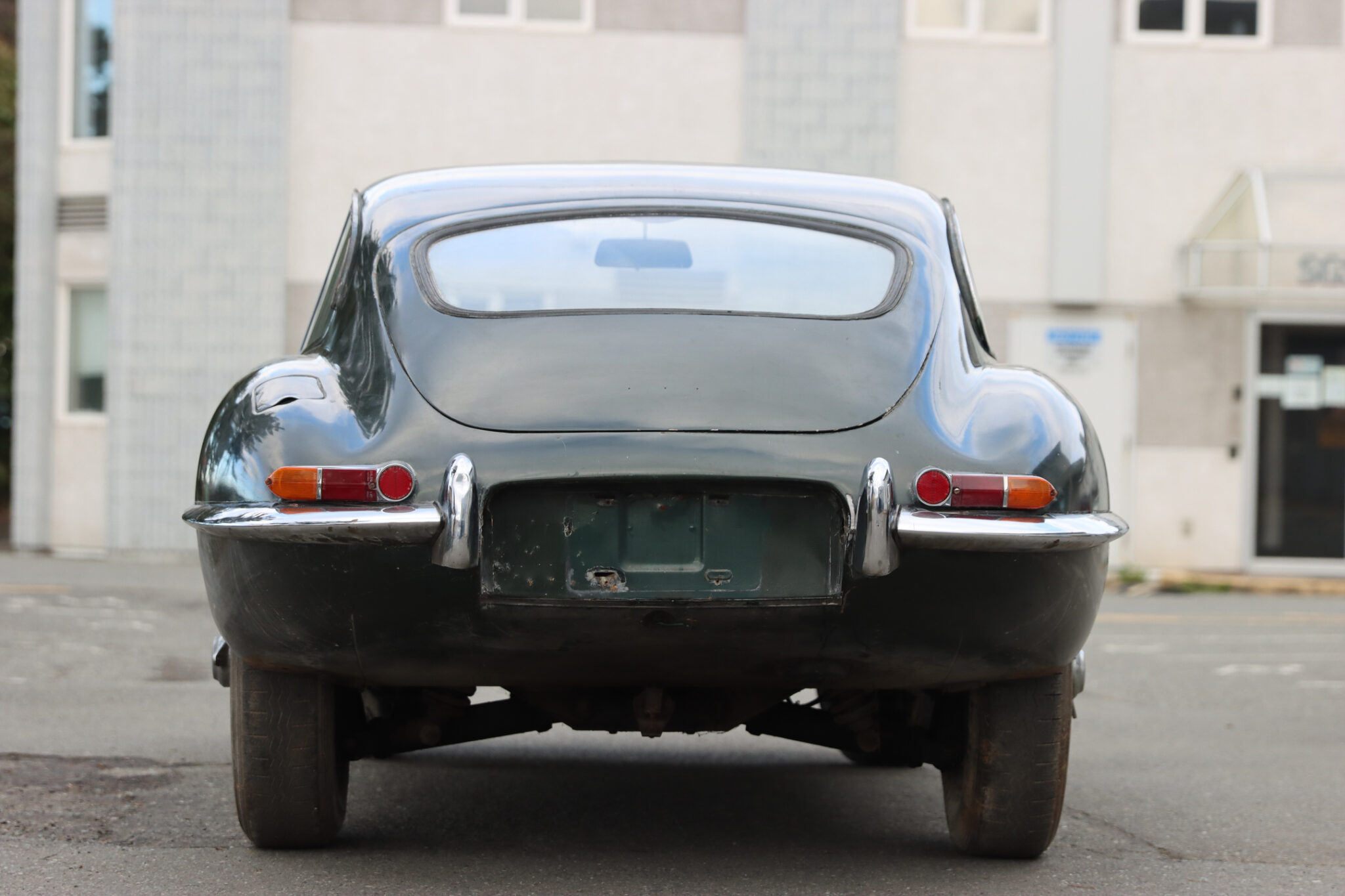
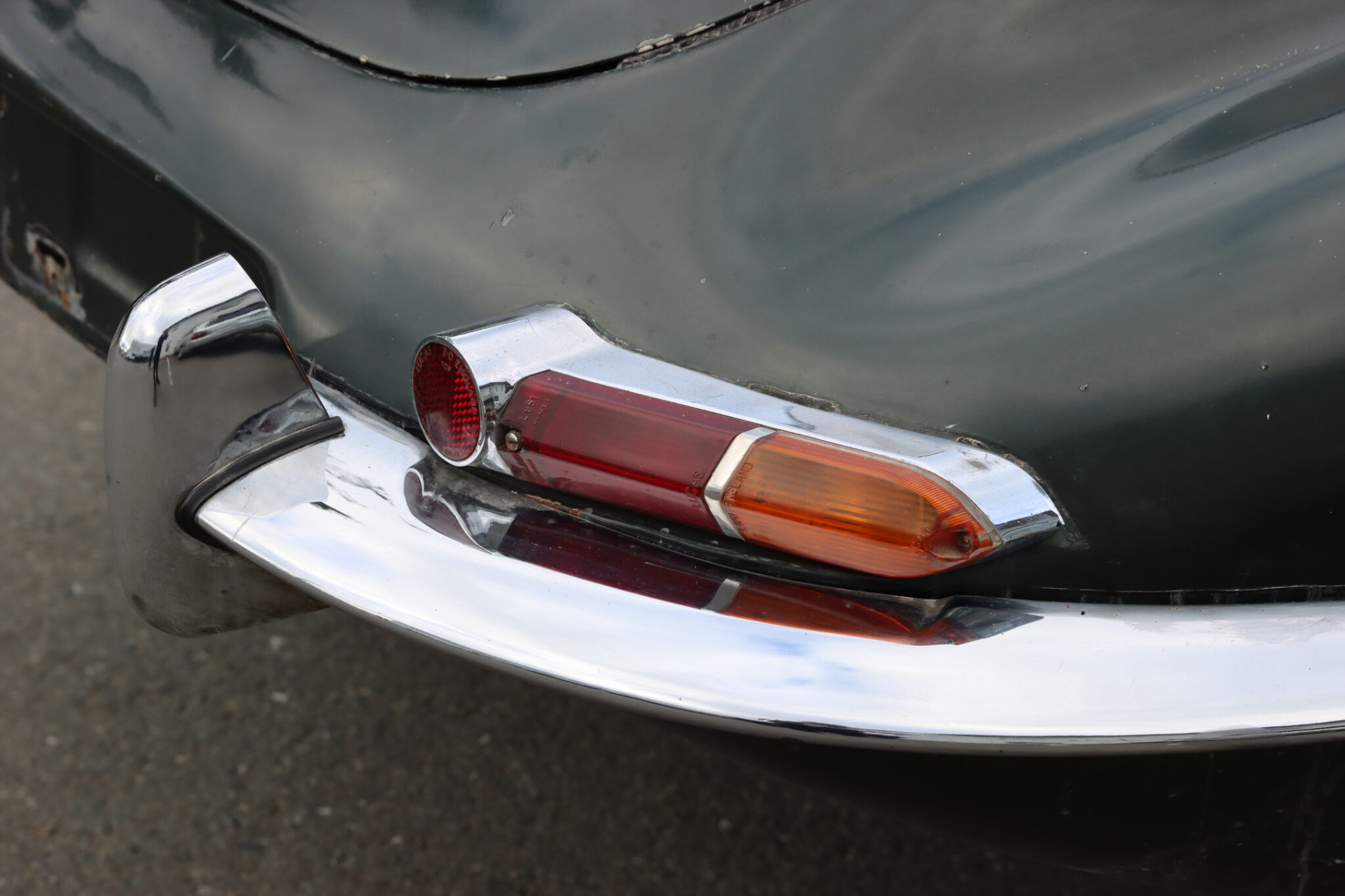
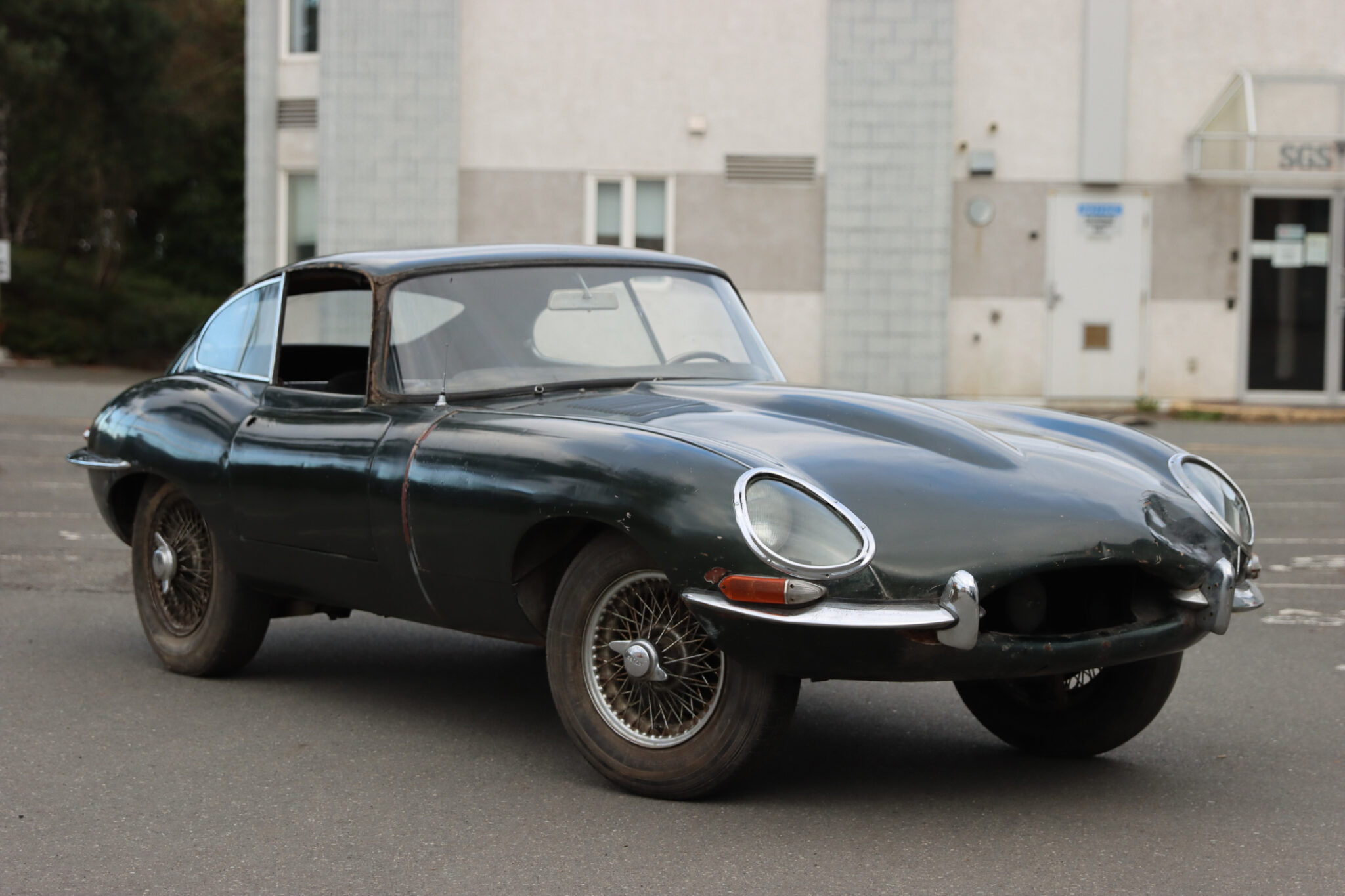
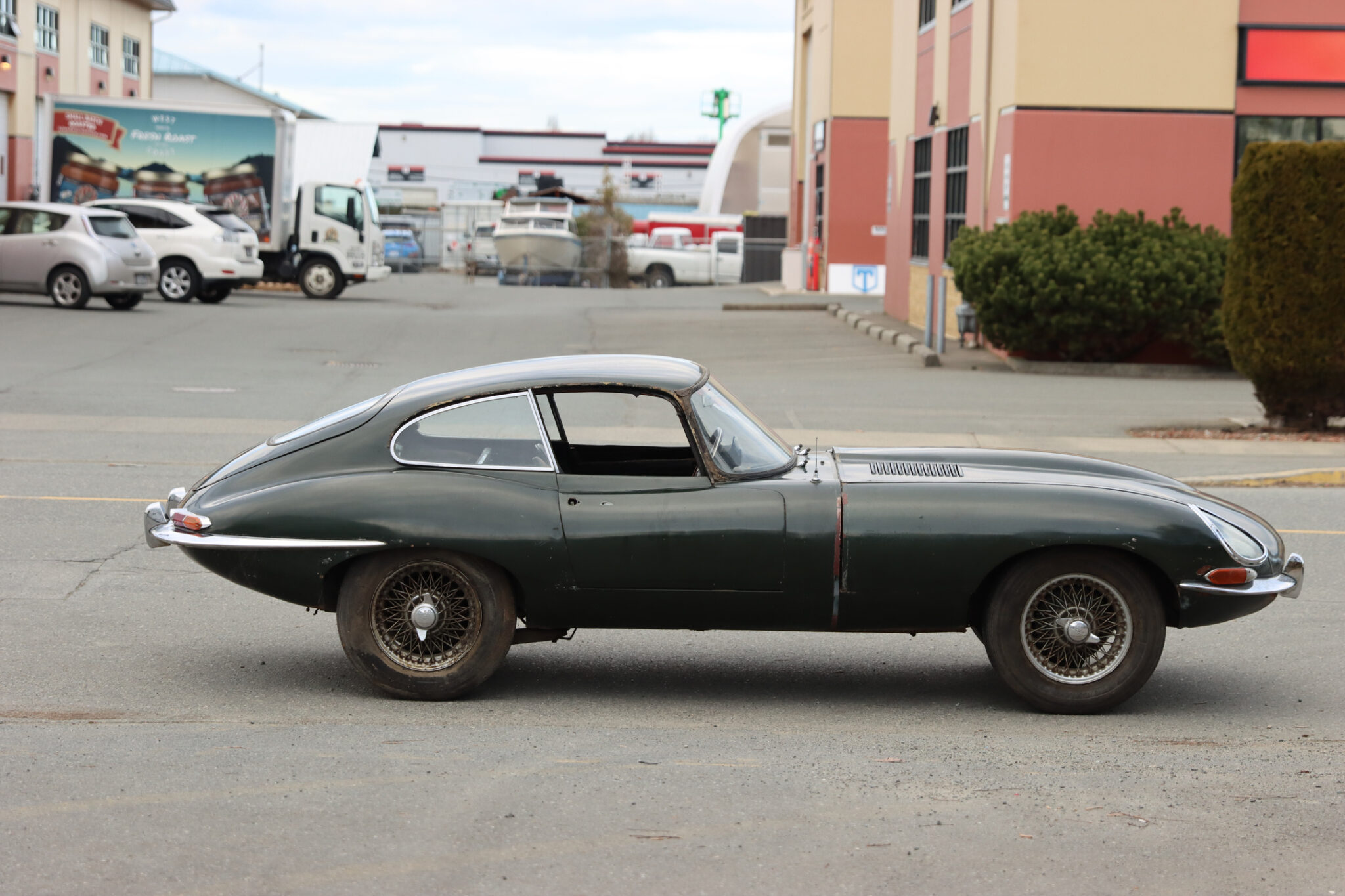
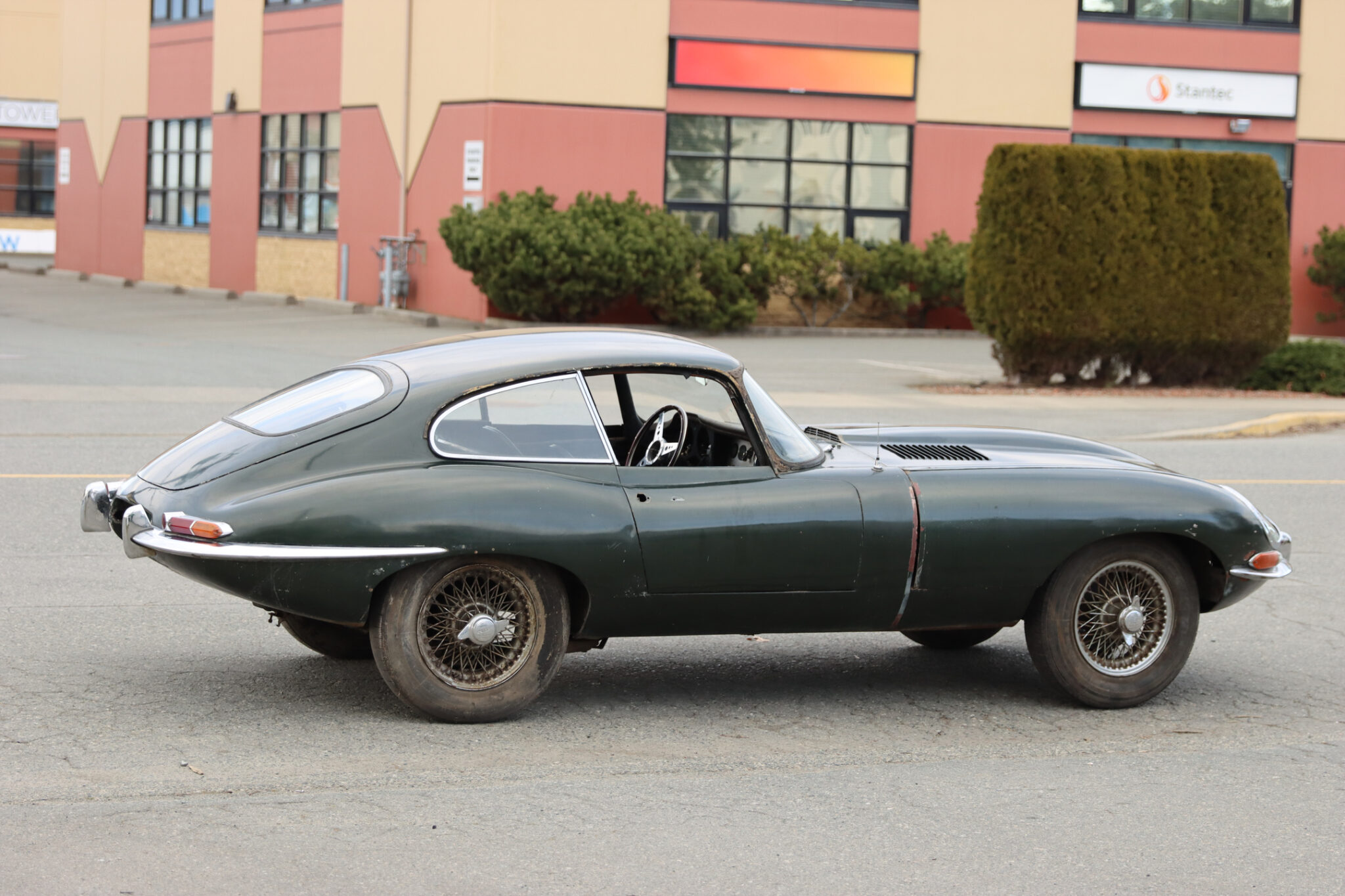
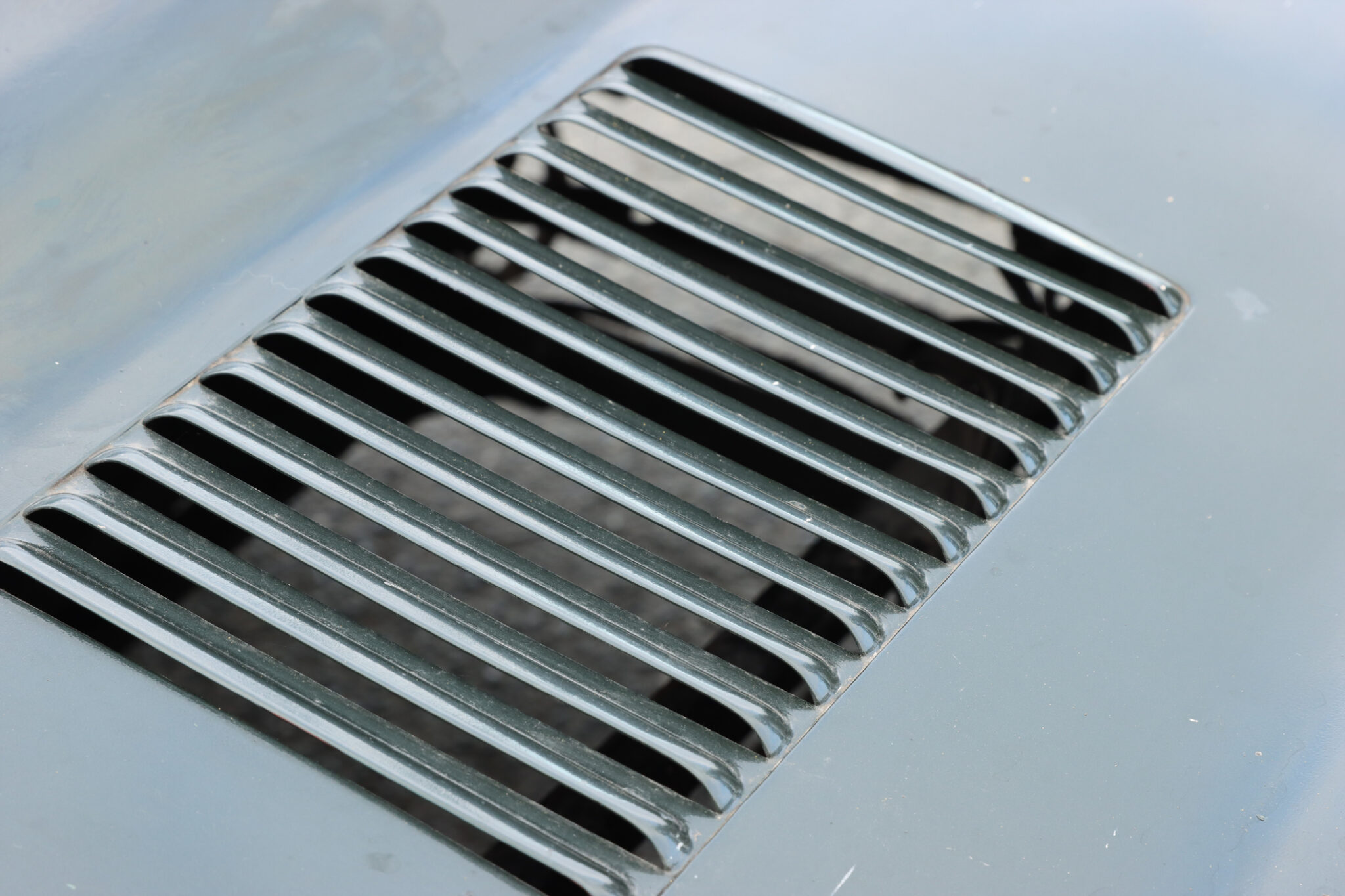
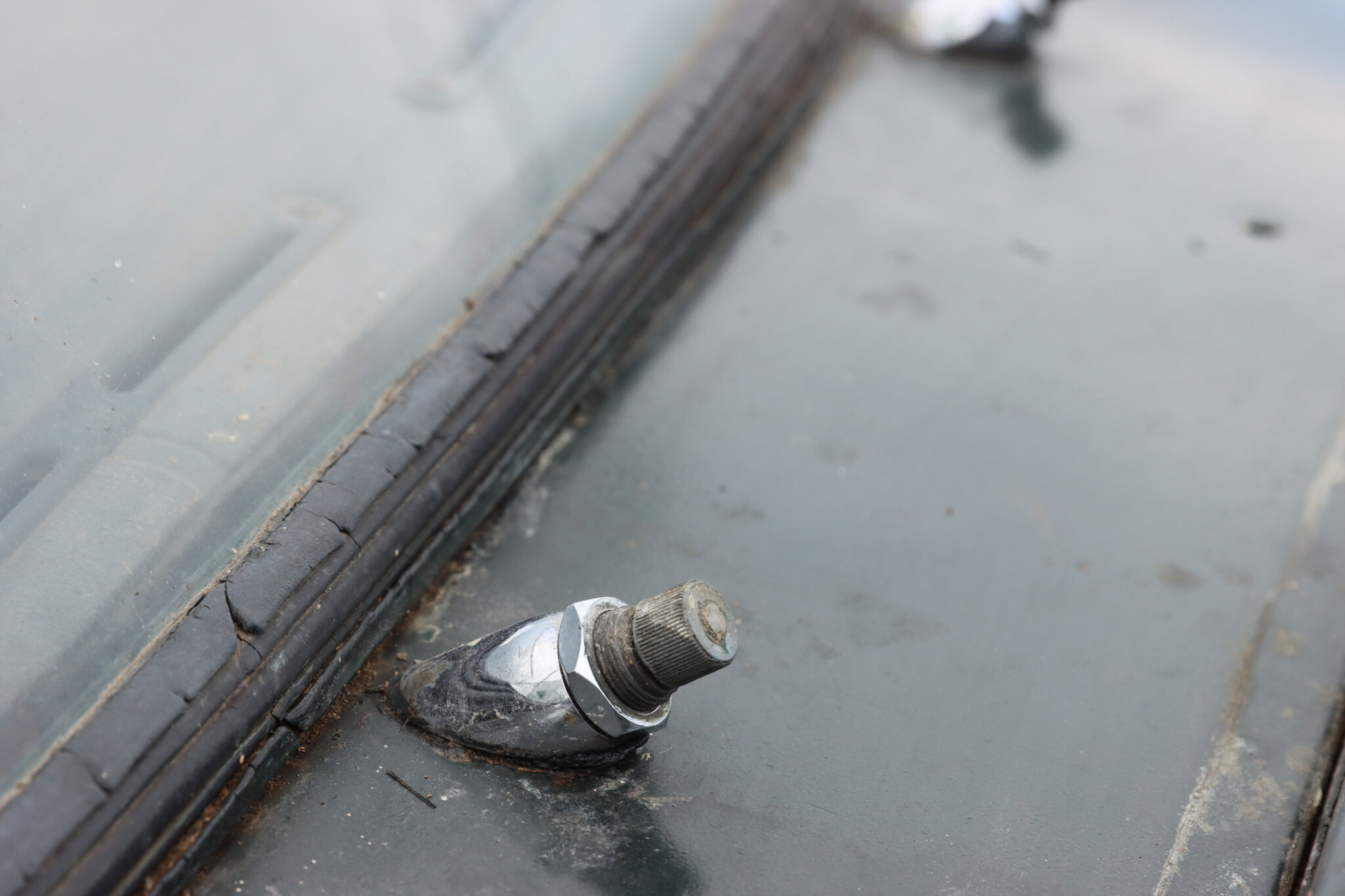
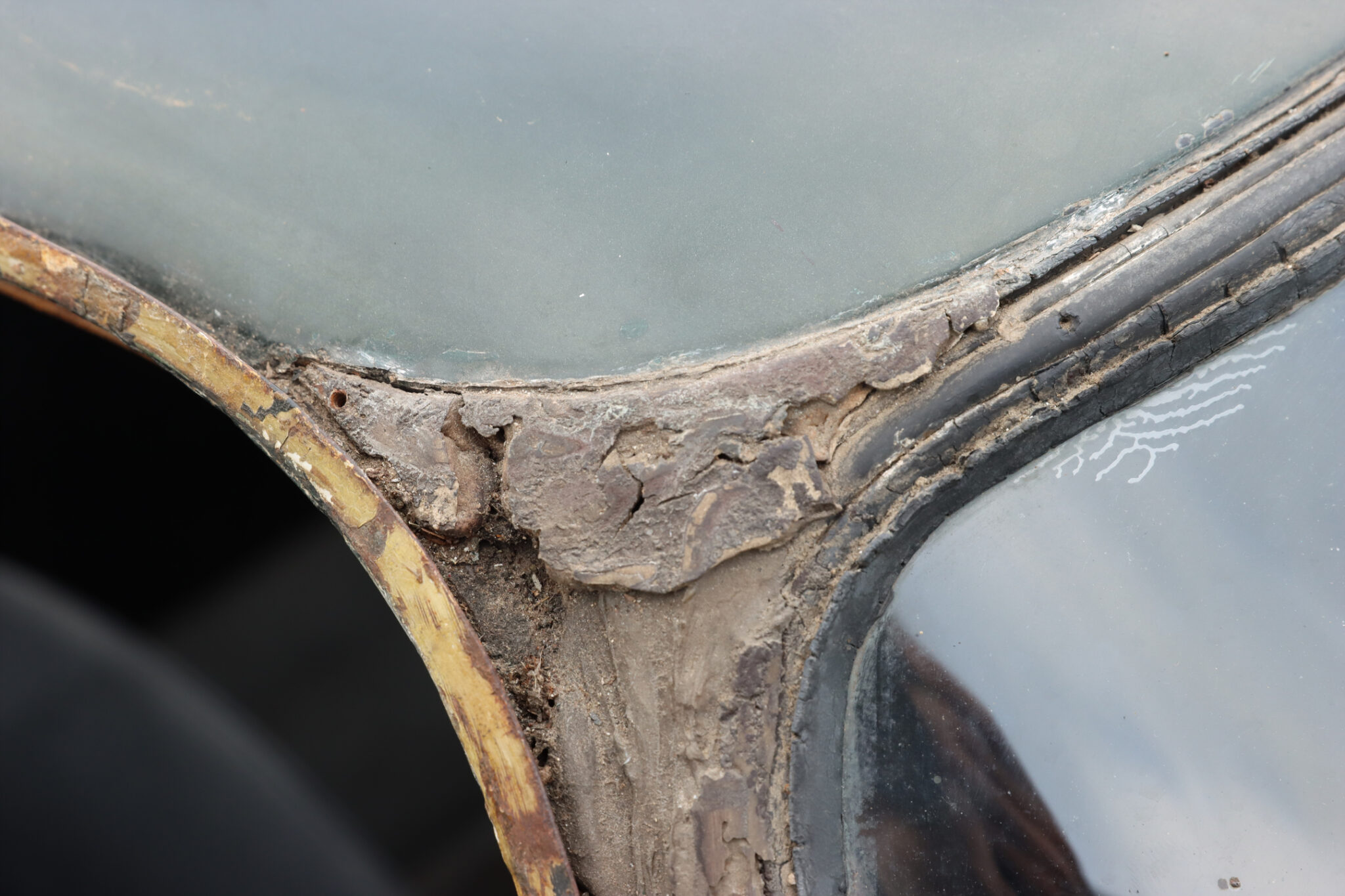
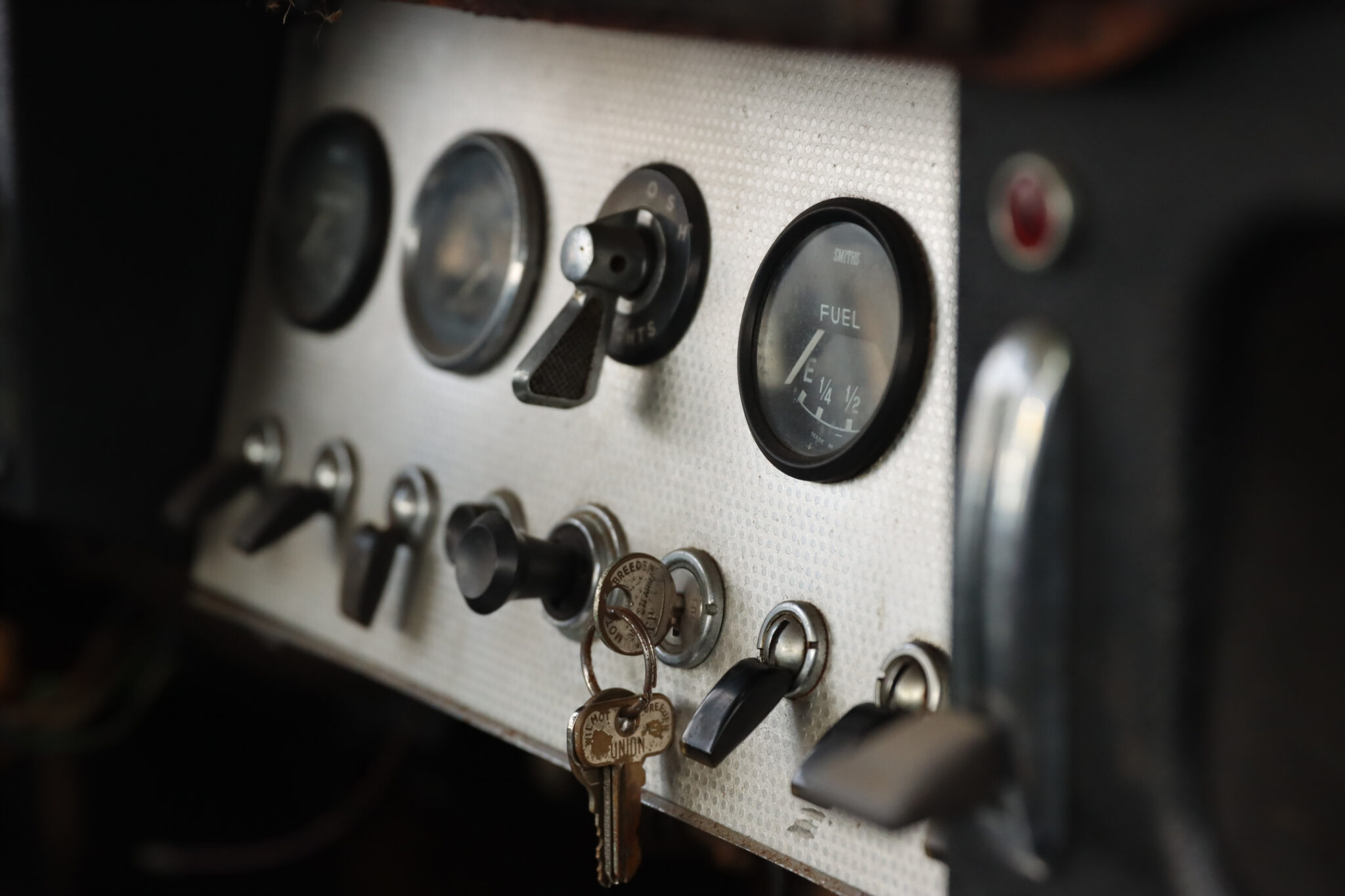
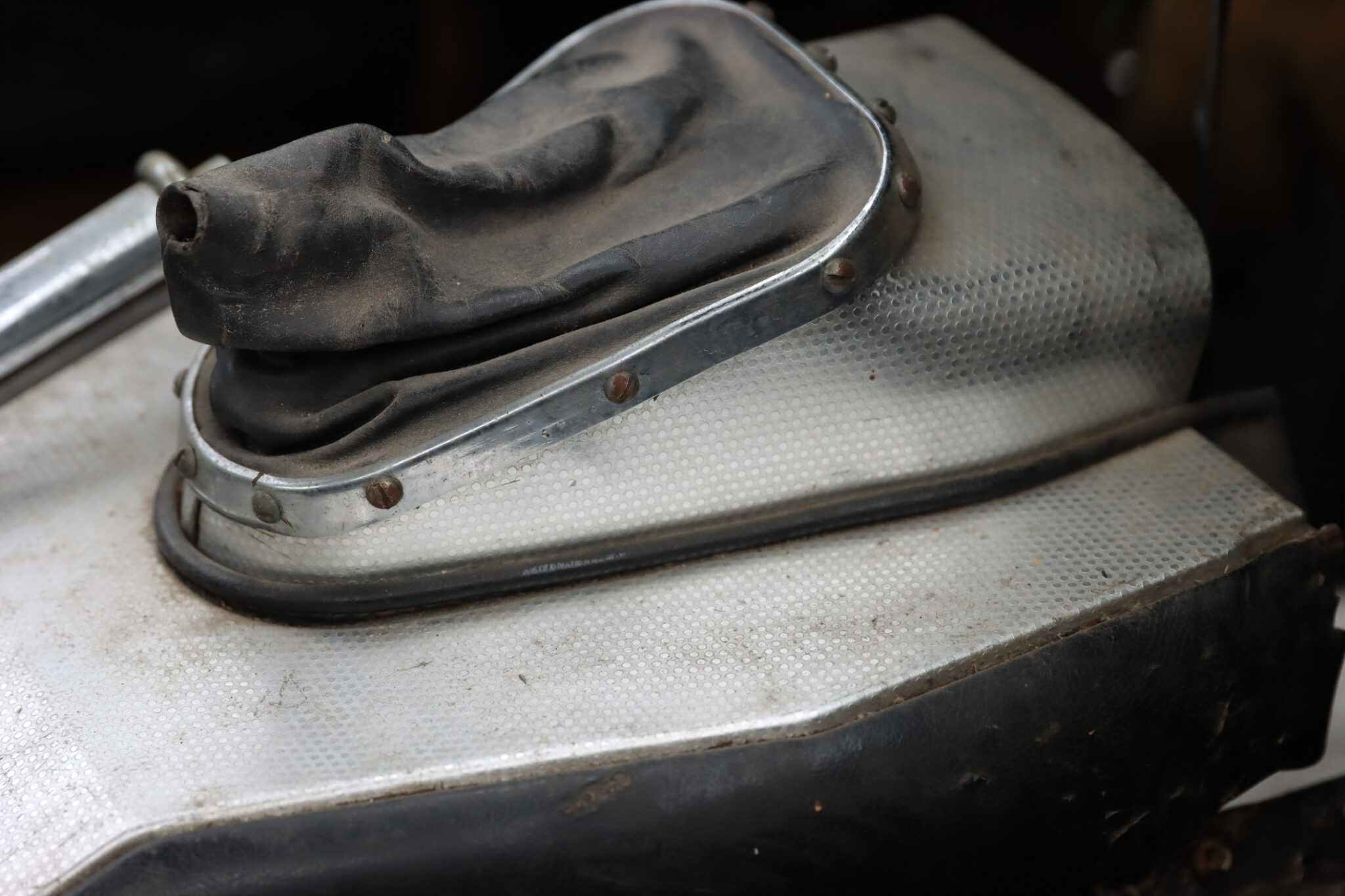
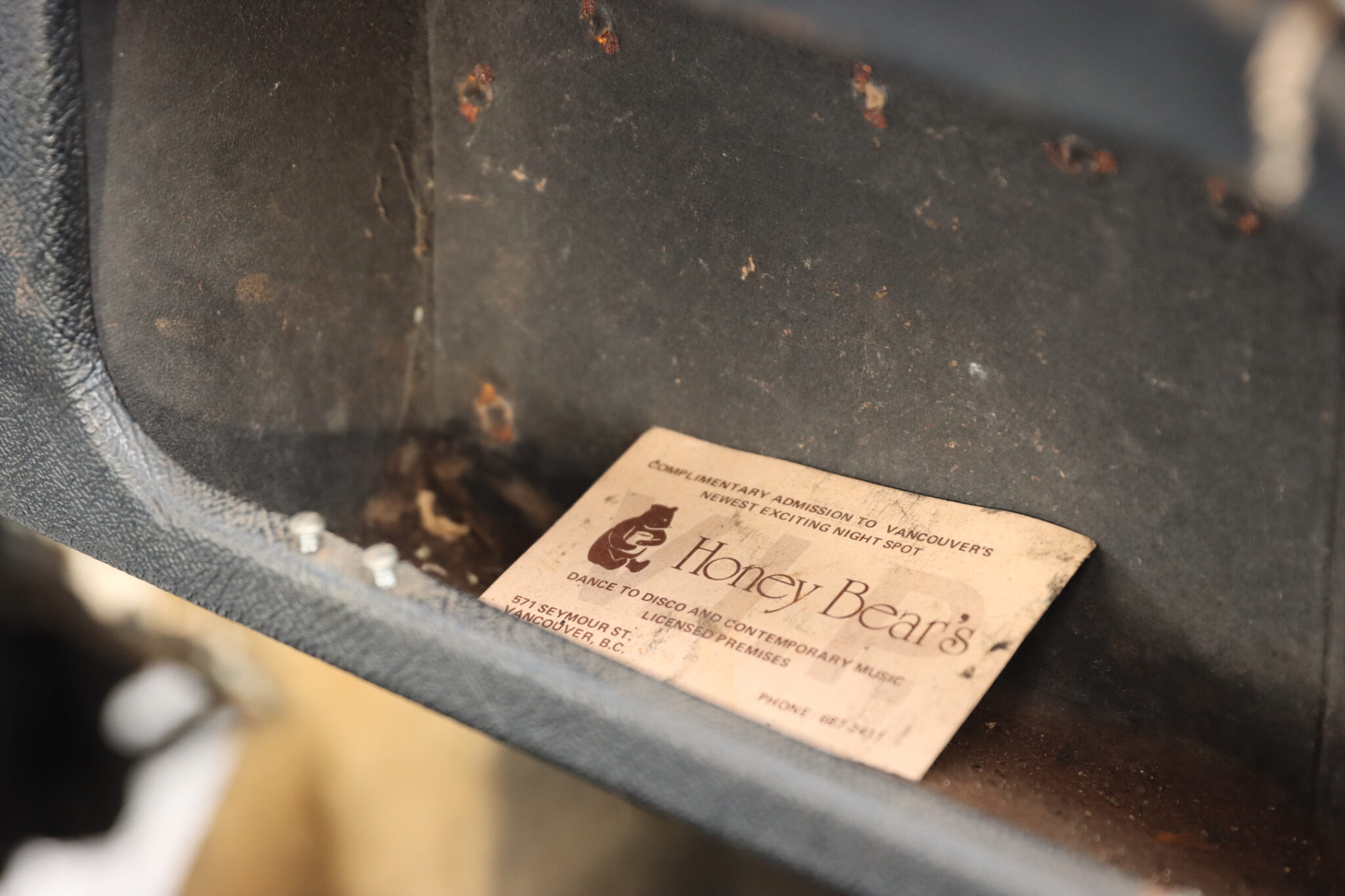



Sir William Lyons wasn’t entirely prepared when he unveiled the Jaguar E-Type to the press and motor trade at the Restaurant du Parc des Eaux Vives before its debut at the Salon de l’Automobile de Genève in March of 1961. At the last minute Lyons rang up test driver Norman Dewis to “drop everything and bring over the open-top E-Type.”
The story is widely told but worth repeating: Jaguar had two Opalescent Gunmetal Coupes at the Restaurant du Parc des Eaux Vives on March 15th, the day before the big show. 885005 sat inside the restaurant for close up impressions while the high speed test car, 885002 better known as ‘9500HP’ was outside for photoshoots where Lofty stood next to it. Later in the day journalists were driven by Bob Barry on a pre-made hillclimb route. The response to the demonstration runs was so overwhelming that Sir William Lyons had Norman Dewis drive a British Racing Green Roadster ’77 RW’ overnight, from England to Geneva, to be at the hillclimb demonstration the next morning. Norman drove from the experimental shop in England at 745pm, caught the 10pm ferry from Dover and ran into dense fog in the night. By the time he got to the Swiss border, the direct route over the alps to Geneva was closed so the longer alternative drive was taken. Norman then arrived just before the 10am deadline in Geneva. He had no time to rest: ’77 RW’ was fitted with new whitewall tires, filled with fuel so Norman could give demonstration rides that day.
In total Jaguar had three cars at Geneva, one placed on a Persian rug as the centerpiece of Jaguar’s display and the two test development cars, essentially straight from the MIRA test track, outside the show for a hillclimb demonstrations.
Chassis 885005. This LHD Fixed Head Coupé was shown to the public at the 1961 Geneva Motor Show sitting on a Persian rug. In May of 1961 it was sold to Mr. Filippinetti of Scuderia Filippinetti and remained in Switzerland almost all its life. It was restored by Dönni Classic Car AG in 2002-2003 where it was found to be “built up on the structure of an already existing convertible body” as the first hand-built experimental coupe body.
Chassis 885002 ‘9600HP’. The second FHC produced refereed to as ‘Hard Top No .02‘. Used as a development car by Norman Dewis and tested at MIRA to 143 mph and later became one of the two Geneva demonstration cars. Was photographed with Sir William Lyons outside the Restaurant du Parc des Eaux Vives in Geneva. Interesting features include a lack of front bumper overriders and no center grill motif bar which was probably to aid the high-speed tests. At some point converted from LHD to RHD. Purchased by author Philip Porter in 1977 and subsequently restored by CMC Classic Motor Cars to a high standard. Philip Porter reports that 885002 still retains its LHD throttle linkage and has a unique aluminum rear hatch panel.
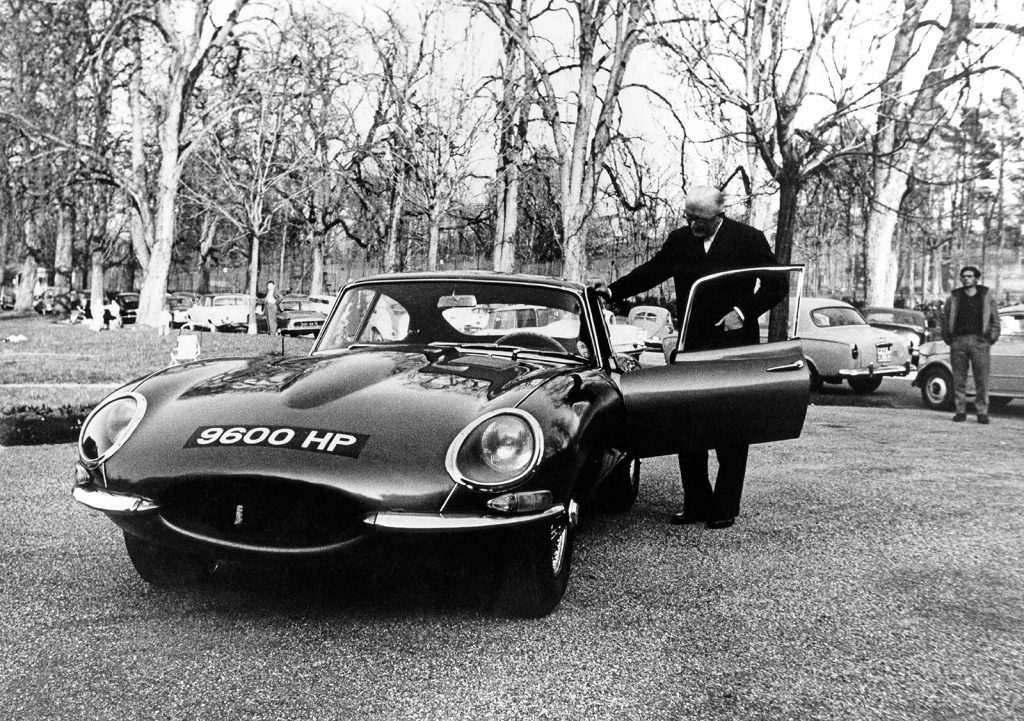
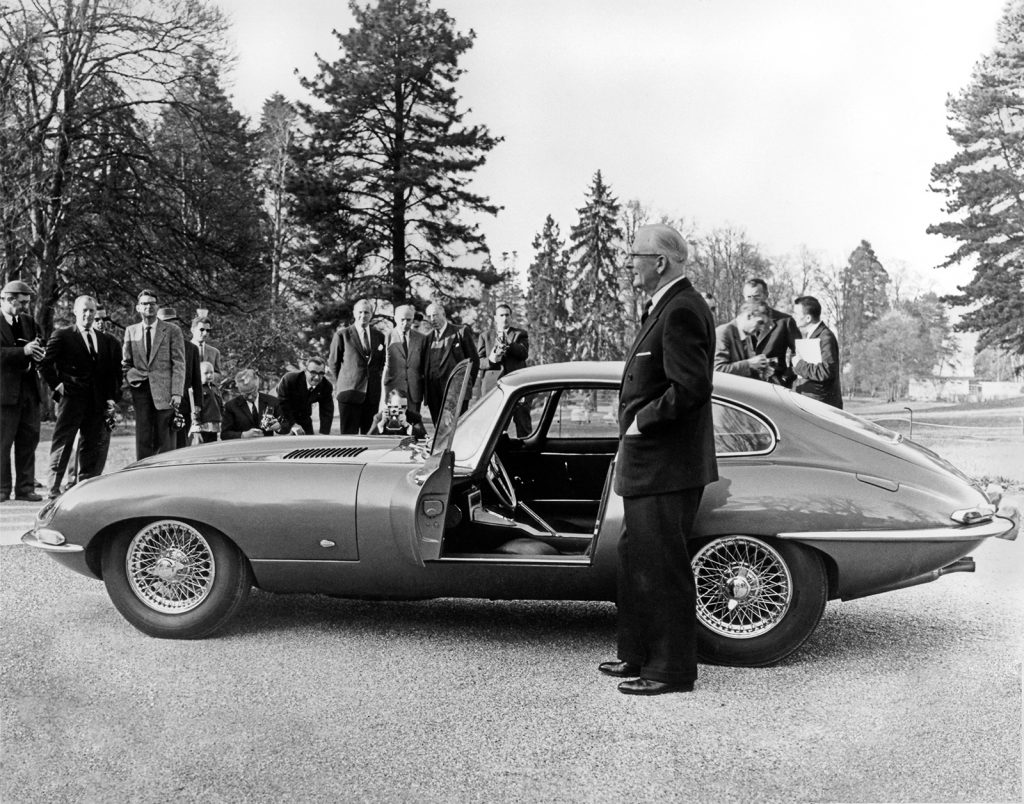

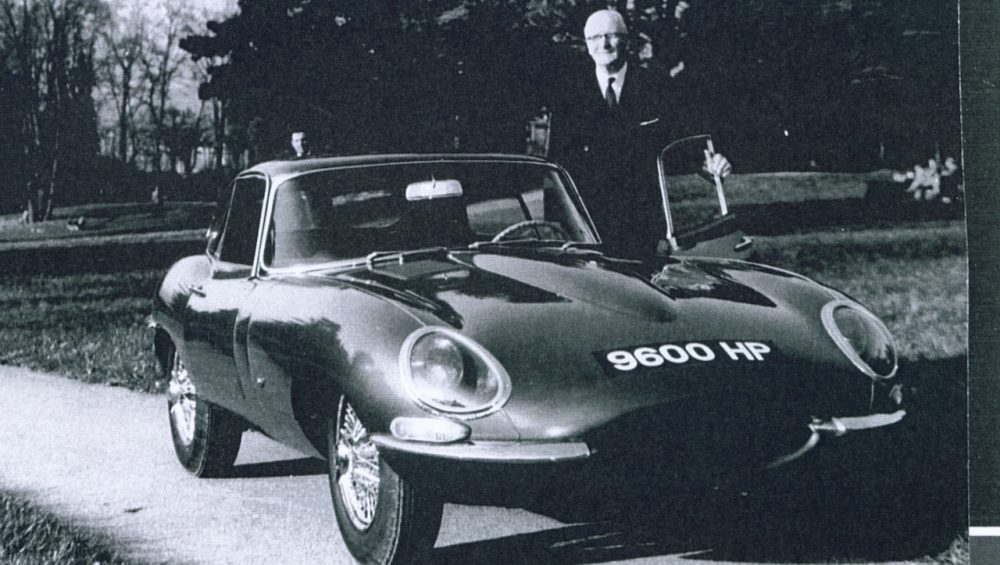
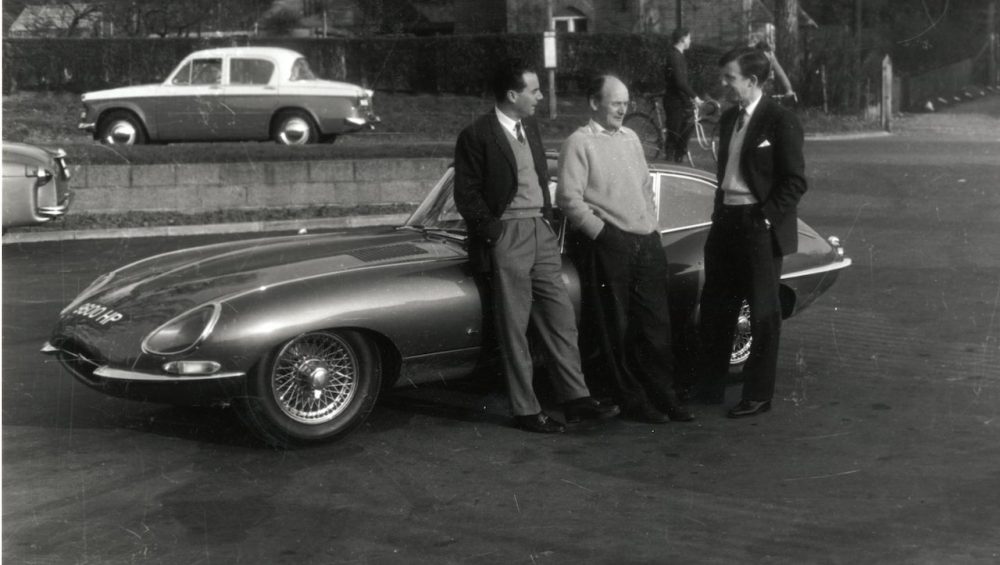
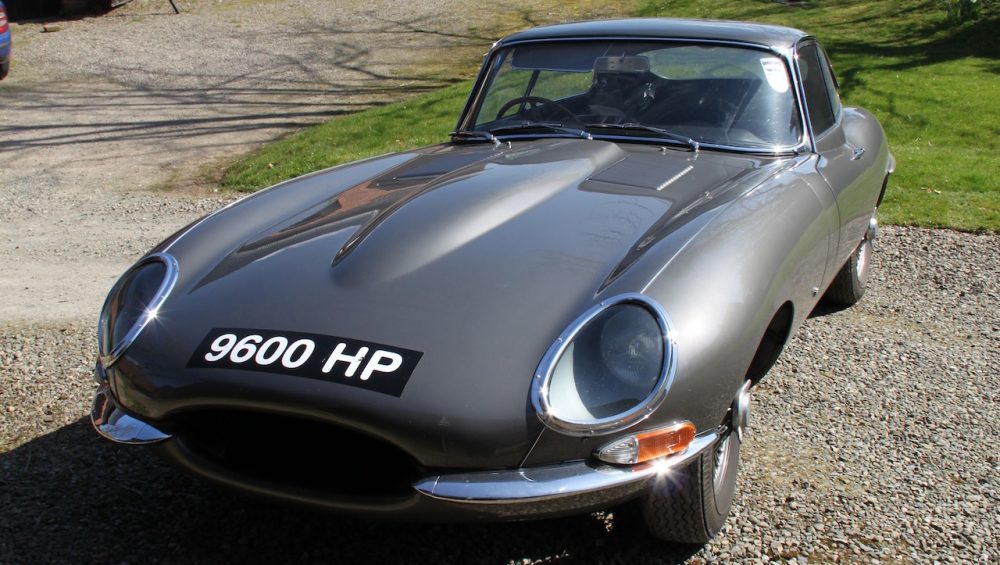
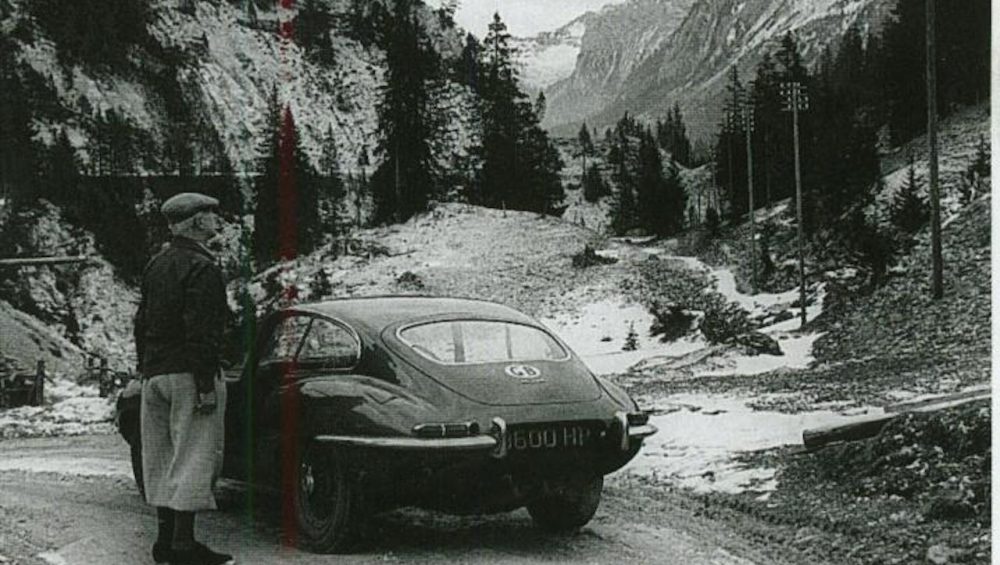
Chassis 850003 ’77RW’. The famous RHD roadster driven by Norman Dewis from the Experimental Department overnight to Switzerland for test drives. This car was initially prepared for MIRA high-speed testing and fitted with the first production E-Type engine R1001-9. Also used as a press car and featured in numerous early articles for The Motor and Autocar who were both able to achieve 150mph.
For the 60th anniversary Jaguar is releasing six matched pairs of restored 3.8 E-types with custom appointments including an engraved centre console by artist King Nerd, commemorative E-type 60th logo on the bonnet badge, fuel cap, chassis plate, a close-ratio 5-speed manual gearbox, Jaguar Classic Infotainment System, alloy radiator and electronic ignition.